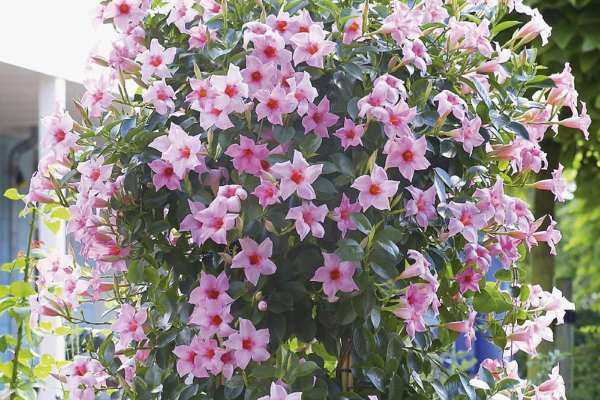What is Dipladenia?
Dipladenia is an extremely popular flowering plant that has lush foliage and bright blooming flowers. It does well in hanging pots and butterfly gardens and is perfect for every landscape, balconies, and patio. They attract butterflies, bees, and hummingbirds.
This plant also known as Mandevilla or rock trumpet, is a tropical flowering perennial shrub native to Central and South America. It belongs to the Apocynaceae family and is a sub-species of the Mandevilla vine.
Dipaldenia is a famous ornamental annual or perennial house plant thanks to its dark glossy leaves and beautiful, voluptuous trumpet-shaped flowers.
These plants are very easy to care for but there are some important growth and care tips that you need to know to keep Dipladenia happy and healthy all summer long.
Also, Read Container Gardening Made Easy: 10 Sun and Shade-Loving Low-Maintenance Plants
How to grow and care for Dipladenia?
As mentioned above, Dipladenia is very easy to care for. However, there are a few things to take care of while growing it. They are mentioned below:
Light
Dipladenia thrives when exposed to direct sunlight and likes full sun to part shade. In hot places, some afternoon shade might be beneficial.
However, there are differences in people’s experience of what their Dipladenia prefers. While some say that the afternoon sun during the summer damages their plant, others claim that the bright scorching sun is their plant’s companion. Check what your plant prefers and if hours of direct sunlight damage your Dipladenia, give it some shade.
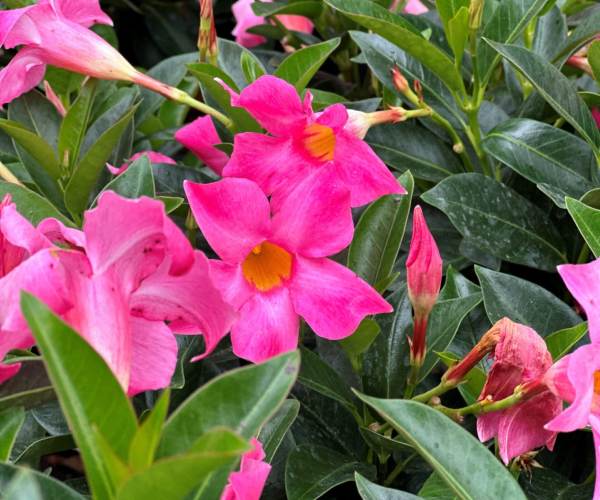
If you’re growing a Dipladenia bush as a houseplant, provide it with bright, indirect sunlight. Keep it near a south-facing window but ensure the direct sunlight streaming through it is limited. This can scorch the plant if exposed for long. It will be better to keep it indoors where it will receive direct morning sun and indirect light in the afternoon.
Water
Diplandenia’s watering choices depend on a couple of things like the time of the year and whether it is growing on pot or ground. Normally, it likes a bit of consistent moisture and well-drained soil during its growing season.
It does not prefer over-watering because it is prone to root rot. Because of its starchy, thick roots once matured, it gets quite drought tolerant and can sustain times of dryness.
If you’re growing yours in the ground, water it only once the top 2 to 4 inches of the soil dried out. However, you have to water it more if you’re growing the Diplandenia in a pot. Check it consistently and water once the top few inches of the soil feel dry.
Indoors, you only have to water once a month, or else the plant will be passive.
Fertilization
Unlike many other plants, Dipladenia isn’t nutrient-hungry and does not need any special nutrients. It is best to provide a general-purpose, slow-release fertilizer at the beginning of the growing season or when the plants look dormant. If necessary, repeat the process around mid-summer. You can use a pellet fertilizer or liquid plant food.
Be aware not to fertilize too much as it might cause leaf discoloration and inhibit flowering due to too much nitrogen.
Does Dipladenia need pruning?
You can prune your Dipladenia whenever needed but just make sure to leave enough foliage near the base of the plant to help it flush out again. It is best to cut off wayward and leggy stems right above the leaf node so that helps the plant to regrow.
The best time to prune Dipladenia is in the spring before it flushes out. It is better to cut back the foliage in the fall before winter arrives.
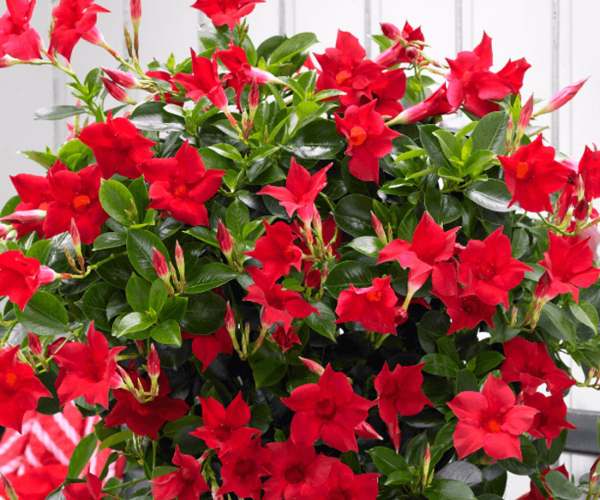
You will notice a milky white sap oozing out from the snipped stems when pruning. This gel is toxic so do not touch with bare skin. Wash your hands thoroughly after pruning or wear gloves for safety.
Along with pruning, frequent deadheading of old Dipladenia flowers will encourage new blooms.
Repotting Dipladenia
Dipladenias normally do not need repotting because they don’t mind being a little root-bound. But once you see the water running straight through or roots coming out of the container, your plant might be asking for repotting.
If your Dipladenia is root bound make sure not to break up the roots too much as they do not like root disturbance.
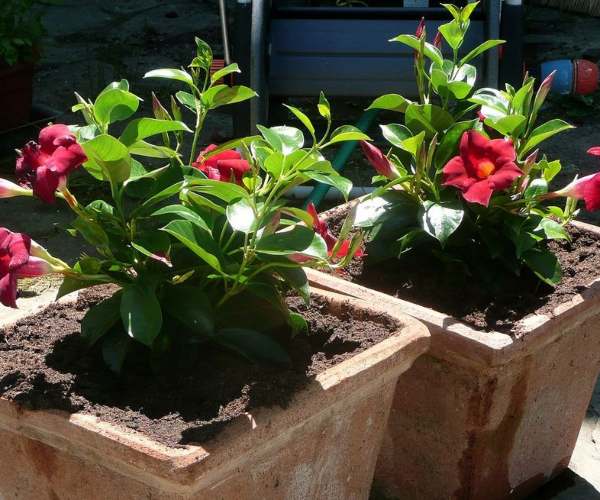
Be gentle and maintain whatever root shape your plant has. Simply transfer it to a new container with a few inches on the outside diameter. Then, fill the outer diameter with your potting mixture.
You can use a multipurpose potting mix and nothing special is needed as the plant is not nutrient-hungry. Mix a little perlite, sand, and/or grit into your potting mixture to support water drainage and prevent overly moist soil.
Plant Pests and Diseases
While Dipladenia won’t get pests or diseases, it might get affected by common pests like aphids, white flies, scale insects, mealy bugs, and spider mites. You can use insecticide soap to get rid of this problem. It can also be affected by common fungal diseases.
Dipladenia propagation
These plants can be successfully propagated through cuttings or layerings.
You have to snip a healthy, sturdy stem about 5 to 6 inches long to make a cutting. It is necessary to cut it right below a node where it has its natural rooting hormones.
Strip back to the bottom leaves, leaving a few leaves at the top to help root growth. After that, you can dip the stem into a rooting hormone which is optional.
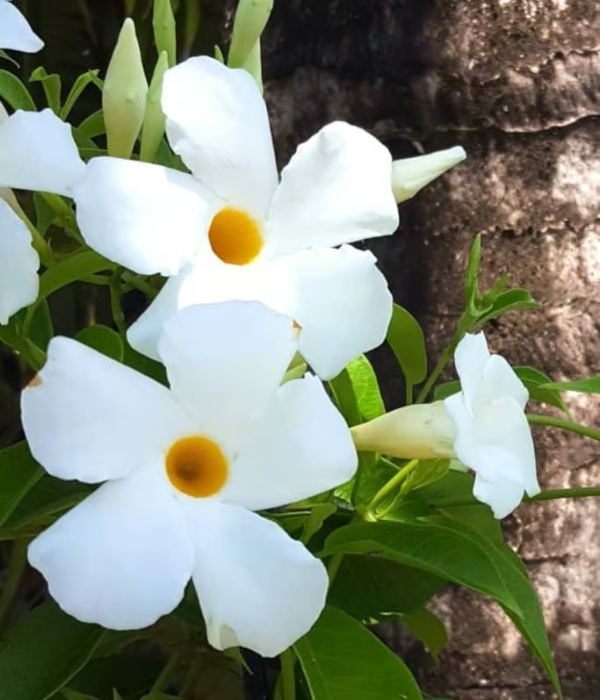
Then, you dip the cutting a few inches down into a moist potting medium and cover it with a plastic bag by not letting it touch the plant. Doing this creates a warm and humid environment for the cutting.
Make sure to keep the Dipladenia cutting out of direct sunlight, keep it warm and you will notice it rooting a few weeks later.
How to care for Dipladenia in winter?
During extreme cold winter, it is better to bring your potted Dipladenia indoors before the first frost. If the plant catches frost, it might be hard for it to survive as they are very cold-sensitive.
These species naturally go dormant from October to April and it is very normal for them to stop growing and drop their leaves during their dormancy period. Water a little during this time as you don’t want it overly moist or the roots may start rotting. Just make sure it doesn’t completely dry out.
Difference between Dipladenia and Mandevilla
Many people often refer to Dipladenia as Mandevilla and vice versa. Garden nurseries often display these tropical beauties as the other which makes it even more confusing. But there is a difference between these two plants.
Dipladenias are the subspecies of the Mandevilla vine. The most recognizable difference lies in their growth pattern. Dipladenias grow as shrubs and Mandevillas grow as vines. Because of this, Dipladenias do not need a trellis or anything to climb on while Mandevilla does.
Also, Dipladenias normally produce smaller flowers than Mandevillas.
FAQs
Q: Is Dipladenia an annual or perennial plant?
A: It is a perennial flowering flower native to tropical and subtropical regions. In colder climates, it is treated as an annual or overwintered indoors as it can not tolerate frost. Its vibrant, trumpet-shaped flowers bloom from spring until the first frost.
Q: Is Dipladenia poisonous to pets?
A: Yes. These plants are toxic to dogs. They contain compounds called cardiac glycosides ², which can cause symptoms like vomiting, diarrhea, and even heart abnormalities if ingested by pets. If your dog ingests Dipladenia, consult a vet as soon as possible.
Q: Do deer eat Dipladenia?
A: While herbivorous animals do eat a variety of plants, this plant is typically not preferred due to its toxic components. But in places of scarcity, deer may still nibble them.
Also, Read Hanging Gardens: Discover 12 Stunning Indoor Plants for Vertical Spaces
